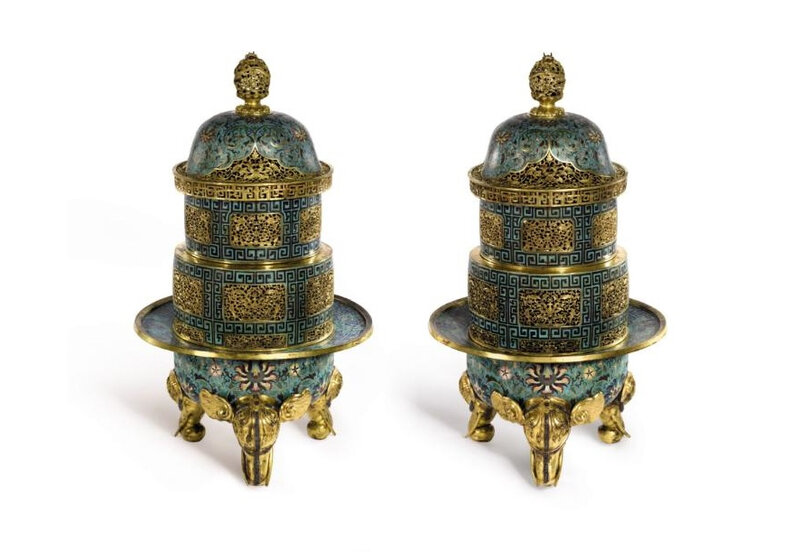A Pair of Massive Cloisonné Incense Burners and Covers, Qing Dynasty, Qianlong Period (1736-1795)



Lot 3103. A Pair of Massive Cloisonné Incense Burners and Covers, Qing Dynasty, Qianlong Period (1736-1795); 103.8 and 104.3 cm., 40 7/8 and 41 in. Estimate 5,000,000 — 7,000,000 HKD. Lot sold 14,440,000 HKD (1,359,410 EUR). Photo: Sotheby's.
each cast with a deep basin rising to a wide rim set, the rim finely enamelled with floral sections containing hydrangea and rocks, a lotus pond, and peonies and rocks, all against a ground of archaistic key-frets, all supported on three gilt cabriole legs in the form of caparisoned elephant heads, each head deftly cast with curved tusks and beaded ornaments, the main body comprising two detachable cylindrical chimneys, the upper register decorated with key-fret motifs in cloisonné enamels and three rectangular pierced and gilt panels enclosing scrolling lotus blooms, the lower section similarly decorated save for an additional three pierced panels of smaller sizes, the domed cover pierced and gilt with lotus scrolls below further scrolling lotus blooms detailed in cloisonné enamels, the rim with a pierced key-fret band, all surmounted by a gilt openwork dragon knop seated on a double-lotus pedestal.
Provenance: A private European family collection (by repute).
Note: onné enamel censers of this magnificent size and outstanding quality are extremely rare and provide a glimpse into one of the most creative periods in Chinese art. The present pair is a fine example of imperial enamel craftsmanship of the Qianlong period when cloisonné enamelling reached its zenith. They also showcase the Emperor’s personal taste which gravitated towards luxurious forms and designs. Glamorous and visually striking, cloisonné enamel was a favoured material by Qianlong and craftsmen working in the Zaobanchuwere encouraged to produce innovative and technically challenging marvels.
Censers of this type can be found from the Qing court collection and still in the halls of the Imperial Palace in Beijing and in the emperor’s summer residence at Shenyang; for example see a pair of censers depicted in situ in the Qingninggong (Palace of Tranquillity) in the Shenyang Palace, published in The Gathering of Select Gems from Shenyang Imperial Palace Museum Collection, Shenyang, 1991, p. 6 (top). The Qingninggong censers are of similar cylindrical form, each raised on three gilt bronze elephant-head supports caparisoned in jewelled garlands. Another similar pair of censers, but with saddle cloths alternating with the elephant heads, was sold separately, one in our London rooms, 13th May 2009, lot 37, and the other in our Monte Carlo rooms, 4th March 1984, lot 234, from the Fonthill Heirlooms, Collection of Lord Margadale of Islay and the collections of Alfred Morrison and Lord Loch of Drylaw.
Another related pair of opulent censers can be seen positioned on either side of the emperor’s throne in the Qianqinggong (Palace of Heavenly Purity), in the Forbidden City, Beijing, illustrated in situ in Qingdai gongting shenghuo [Life in the palace during the Qing dynasty], Beijing, 1985, p. 56, pl. 69. Although the Qianqinggong censers are of octagonal form they are similarly constructed of two tiers and supported on similar gilded elephant heads. A further pair of large cylindrical censers, formerly in the collections of T.B. Kitson, C. Ruxton and Audrey B. Love, illustrated in publications such as Sir Harry Garner, Chinese and Japanese Cloisonné Enamel, London, 1962, pl. 72 (one of the pair), was sold at Christie’s New York, 20th October 2004, lot 354. A smaller imperial censer, from the Qing Court collection and still in Beijing, is included in The Complete Collection of Treasures of the Palace Museum. Metal-bodied Enamel Ware, Hong Kong, 2002, pl. 149, cast with openwork depicting clouds and bats. See another smaller censer with elephant-head feet, placed next to the emperor’s nuptial bed in the Kunninggong (Palace of Earthy Tranquillity), in the private quarters within the Inner Court of the Forbidden City, published in situ in Kokyu Hakubutsuin ten [Palace Museum exhibition], Tokyo, 1985, p. 47.
The Qianlong period saw a great resurgence and expansion in cloisonné making, notable in the expansion of vessel forms and new applications. Censers of this formidable size and lavish finish were part of the palace furnishing and also used for rituals, banquets and imperial ceremonies. The intricately cast gilt openwork was carefully designed to allow the delicate scent of incense to permeate the hall and reverence for the past is indicated by the form which has been inspired by archaic bronze tripod ritual vessels.
The elephant heads supporting the body are also reminiscent of Ming dynasty censers. See a copper censer with three elephant-head shaped legs, with a Xuande mark and of the period, included in the Special Exhibition of Incense Burners and Perfumers Throughout the Dynasties, National Palace Museum, Taipei, 1994, cat. no. 54; and a Jingtai mark and period censer also in the National Palace Museum, published in masterpieces of Chinese Enamel Ware in the National Palace Museum, Taipei, 1971, pl. 3. The Qianlong Emperor was a keen follower of Buddhism and saw himself as the religious leader of the empire. Reference to his much-beloved religion can be seen in the use of the elephant, one of the most sacred animals in Buddhism.
Sotheby's. Fine Chinese Ceramics and Works of Art, Hong Kong, 08 April 2014

/https%3A%2F%2Fprofilepics.canalblog.com%2Fprofilepics%2F1%2F0%2F100183.jpg)
/https%3A%2F%2Fstorage.canalblog.com%2F03%2F02%2F119589%2F96711876_o.jpg)
/https%3A%2F%2Fstorage.canalblog.com%2F11%2F31%2F119589%2F94773502_o.jpg)
/https%3A%2F%2Fstorage.canalblog.com%2F20%2F83%2F119589%2F94772815_o.jpg)
/https%3A%2F%2Fstorage.canalblog.com%2F26%2F72%2F119589%2F75604929_o.jpg)
/https%3A%2F%2Fstorage.canalblog.com%2F59%2F60%2F119589%2F26458628_o.jpg)




/http%3A%2F%2Fstorage.canalblog.com%2F40%2F03%2F119589%2F128033234_o.jpg)
/http%3A%2F%2Fstorage.canalblog.com%2F09%2F54%2F119589%2F127828285_o.jpg)
/http%3A%2F%2Fstorage.canalblog.com%2F44%2F04%2F119589%2F76379864_o.jpg)
/http%3A%2F%2Fstorage.canalblog.com%2F11%2F49%2F119589%2F72004728_o.jpg)